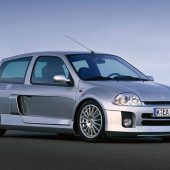Volkswagen Scirocco debuted at the Geneva Motor Show in 1974. It succeeded the Karmann Ghia (internally designated the Type 14) that since 1966 had written automotive history with a fascinating design, proven Beetle technology and affordable prices. Like the Type 14, the Scirocco (developed under the code name EA398) was created at Karmann in Osnabrück. While the Karmann Ghia tended to appeal to women customers, the Scirocco, designed by Italdesign in Turin, appealed equally to female and male car drivers. With its clear, defined edges, emphatic wedge shape, low belt line and taut rear end, the design originated from the same form language that Giorgetto Giugiaro also favored for the first Golf.
Volkswagen Scirocco had classic sports car proportions with its long wheelbase (2.40 meter), extended hood and short fastback with integrated Bürzel spoiler. Total length of the car was 3.85 meter. The interior of the first Scirocco spoke to the styles of the 1970s. The diamond tartan pattern of the seat covers in the top TS model was as much a part of those contemporary taste trends as the corduroy materials and a steering wheel whose three spokes had stamped out holes. In the more sporty versions, two additional instruments (clock and voltmeter) in the center console added another dose of visual dynamics. Later, as part of an initial model facelift, Volkswagen replaced the steering wheel by a version with a deeply drawn impact absorber.
For a sports coupe, its well-organized layout was astonishingly good; the large tailgate and folding rear seats turned the Volkswagen Scirocco into a wagon-coupe with up to 533 liters cargo capacity. Moreover, Volkswagen implemented the most advanced drive technology of its time: transverse-mounted engines, which were now of course water-cooled, and whose overhead camshafts were driven by a quiet toothed belt. In addition to the front independent McPherson suspension with A-arms and negative offset, a semi-independent rear suspension arrived as a genuine innovation.
At its market introduction in June, Volkswagen offered the new coupe with three engines: 1.1-litre with 50 hp and 1.5-litre with 70 hp or 85 hp. The standard manual transmission had four gears and three-speed automatic transmission was available as an option. Depending on the version (Basis, L or TS), a first generation Scirocco had either single rectangular or dual round headlamps. In the most powerful variant, the Scirocco TS, the sports car reached 175 km/h, impressive for those times, and it handled the classic Sprint from 0 to 100 km/h in eleven seconds.
In 1974 the VW sold 24,555 Sciroccos, and in its first full year of production (1975) 58,942 units were sold. A representative survey among Scirocco buyers confirmed the accuracy of the concept embedded in the specification: 42 percent of respondents purchased the Volkswagen based on its design, 25 percent due to its sportiness, and a full eleven percent cited “economy” as the main criterion for their decision to buy.
In the summer of 1976 the Volkswagen Scirocco GTI was introduced. It had a 1.6-litre engine with Bosch K-Jetronic fuel injection producing 110 horsepower. GTI could reach a top speed of 185 km/h. The GLI version also had 110 hp under its flat hood, but it emphasized luxurious attributes with its bronze tinted windows, high-end fabrics and metallic paint.
For the 1978 model year, Volkswagen subjected the Scirocco to a careful model facelift. The front turn signal lights and the bumpers covered with dark PVC impact protection profiles wrapped around the fenders, and the B-pillars were tinted black. At the same time the radiator grille got a decorative frame. The engine lineup was now: 50, 70 and 110 hp. When the last of the first generation Sciroccos left the assembly line at the Karmann factory in Osnabrück in February 1981, a total of 504 153 Sciroccos had been built.










